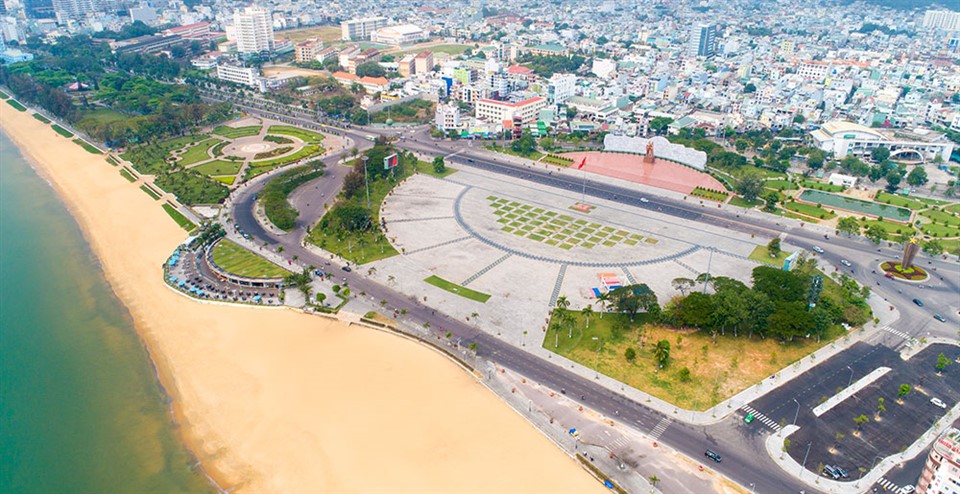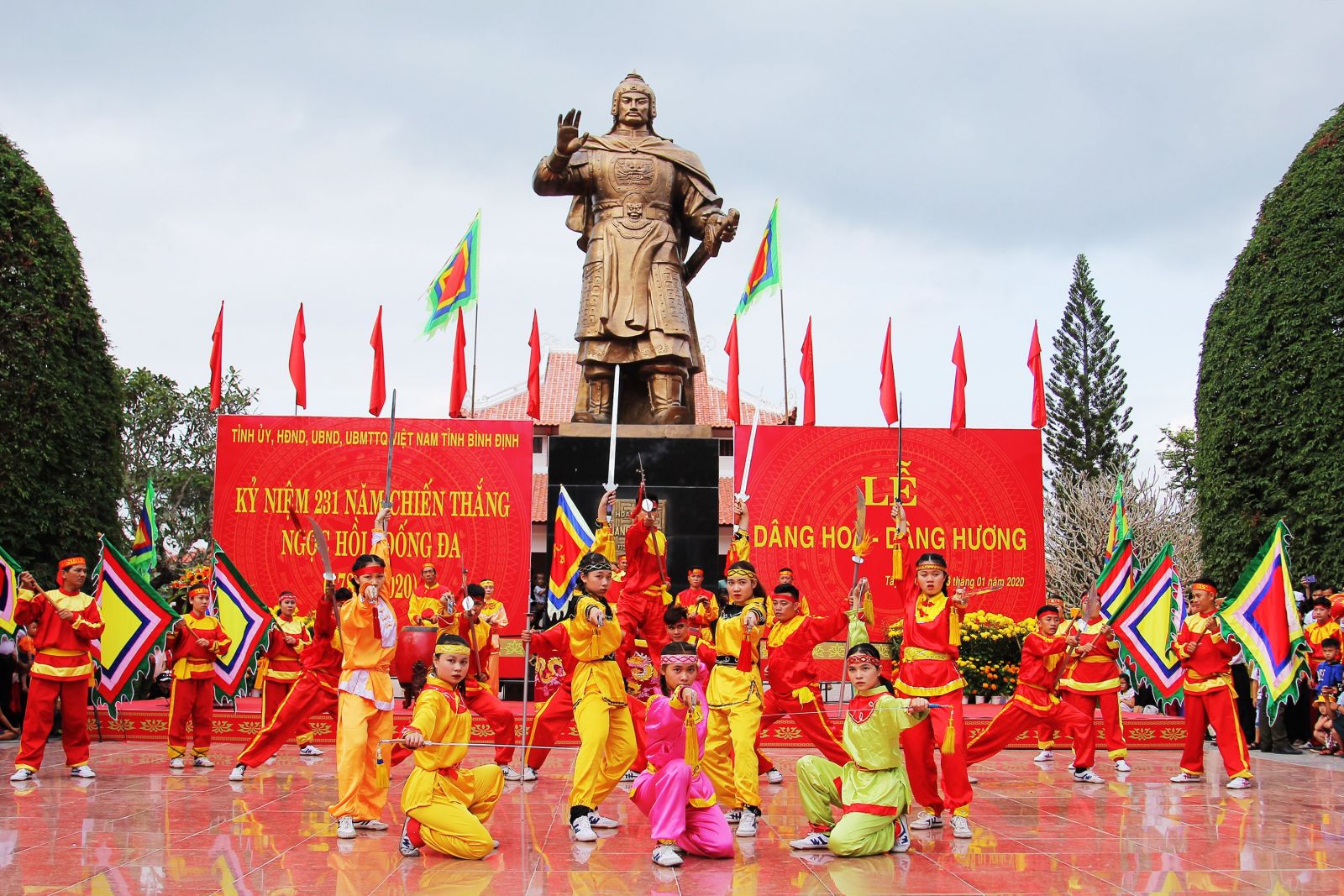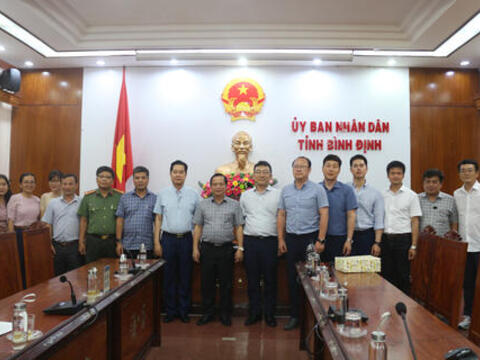Binh Dinh is located in the South Central Coast region, in the Central Key Economic Zone. Binh Dinh has a natural area of 6,071.3 km2; population in 2019 is 1,487,900 people; including 09 districts, 02 towns and Quy Nhon city. Quy Nhon city is a grade I city directly under Binh Dinh province (recognized according to Decision No. 159/QD-TTg dated January 25, 2010 of the Prime Minister).

Binh Dinh has a particularly important geo-economic position in exchanging with countries in the region and internationally; located in the middle of the North - South Vietnam railway and road traffic axis, and at the same time is the nearest and most convenient gateway to the East Sea of the Central Highlands, Southern Laos, Northeast Cambodia and Northeast Thailand through Highway 19 and Quy Nhon international seaport. In addition to this advantage, Binh Dinh also has natural resources, rich human resources and abundant human resources. In the master plan for socio-economic development of Binh Dinh province to 2020 approved by the Prime Minister (according to Decision No. 54/2009/QD-TTg dated April 14, 2009), Binh Dinh is identified as Determined to strive to become a province with a modern industry and one of the centers of socio-economic development, actively contributing to the development of the Central Key Economic Zone and the whole country, life People's lives are improved and enhanced, the ecological environment is protected, security and defense are always guaranteed.
Road, railway, waterway, air and sea transportation systems are quite convenient. National Highway 1 section through Binh Dinh is 118 km long, National Highway 1D section through Binh Dinh is 20.7 km long, National Highway 19 passes through Binh Dinh is 69.5 km long, in addition, there are National Highway 19B, National Highway 19C, the system provincial roads (total length 506 km), district roads and rural roads; Average vehicle traffic day and night is about 2,500-2,700 vehicles. Highway 19 connects Quy Nhon international seaport with provinces in the North Central Highlands region through international border gates of Duc Co, Bo Y and the 3 border region of Vietnam - Laos - Cambodia, is one of the roads in the current horizontal axis system in Central Vietnam, creating favorable conditions for East-West linkages, promoting economic exchanges and development cooperation with outsiders. Currently, the province is investing in the route Phu Cat Airport - Nhon Hoi Economic Zone, Canh Vinh (Van Canh) - Quy Nhon, a new National Highway 19 route, a coastal route to facilitate connection of regions, economic sector. Phu Cat Airport is far from Quy Nhon city 30 km to the northwest, has a runway 45 meters wide and 3,050 meters long. Routes Quy Nhon - Ho Chi Minh City, Quy Nhon - Hanoi and vice versa have flights of Vietnam Airlines, Vietjet Air, Jetstar Pacific, Bamboo airways. Phu Cat airport has been upgraded with a capacity of over 1.5 million passengers/hour. The North-South railway passing through Binh Dinh is 148 km long, including 11 stations, of which Dieu Tri station is the major station, serving as the focal point for all types of trains on the railway. In addition to North-South trains, there are also fast trains from Quy Nhon to the South Central provinces to Ho Chi Minh City and out to Nghe An.
Binh Dinh has Quy Nhon international seaport, Thi Nai port and Mien Trung Newport, in which Quy Nhon international seaport is capable of receiving ships of 50,000 tons, about 6 nautical miles from buoy No. 150 nautical miles international. The volume of goods passing through Quy Nhon Port in 2018 reached over 8.2 million TTQ, striving to reach over 10 million TTQ by 2020.
Binh Dinh is a province with potential for marine economy; with a coastline of 134km; territorial sea of 2,500 square kilometers, exclusive economic zone of 40,000 square kilometers; There are fishing ports Nhon Chau, Quy Nhon, Tam Quan, De Gi and Tam Quan boat parking area. Of the fishing ports mentioned above, Nhon Chau fishing port is the best, with rich seafood resources, high economic value such as mackerel, tuna, scad, herring, anchovies, flying fish, shrimp. squid and rare specialties (salanganes' nests, king crabs, sea cucumbers...). The total number of boats is nearly 8,000, most of which are offshore fishing boats. The annual production of seafood is about 100,000 tons.

Total water surface area is about 10,920ha (excluding 67,000ha of sea surface). In which, Thi Nai lagoon 5,060ha, De Gi lagoon 1,600ha, Tam Quan estuary 300ha and a number of freshwater ponds and lakes...are favorable conditions for aquaculture development. Currently, there are 2,648 hectares of water surface for shrimp farming.
Binh Dinh has 04 major rivers, namely Kon River, Lai Giang River, La Tinh River and Ha Thanh River. Currently, there are about 135 natural and artificial lakes with a total area of 38,000 hectares, dedicated to providing water for crops and plants aquaculture. The network of rivers and streams is concentrated in mountainous areas, creating favorable conditions for the development of irrigation and hydropower; total water reserve is about 5.2 billion m3; hydropower potential is about 182.4 million kW. Binh Dinh has developed and implemented the provincial electricity development plan for the period 2016 - 2025 with a vision to 2035 with the goal of ensuring a balanced, harmonious and synchronous development between source and grid development, meeting the requested for socio-economic development of the province (Decision No. 3145/QD-UBND dated August 30, 2017 of Binh Dinh Provincial People's Committee). Over the years, we have taken advantage of the World Bank's capital to invest in medium and low voltage. Up to now, 100% of communes have grid electricity (except Nhon Chau island commune, which is building a power grid using submarine cables across the sea) and over 99% of households use electricity. Change the model, license electricity activities, operate the low-voltage grid safely, apply many measures to improve power quality, reduce power loss, ensure electricity selling price to households countryside.
Quy Nhon water plant has been invested and upgraded with a total capacity of 45,000 m3 / day and night (will continue to increase to 48,000 m3 / day and night), currently providing water for more than 90% of the population and production business activities in Quy Nhon city and a part of Nhon Hoi economic zone. Water supply capacity for Phu Tai Industrial Park: 8,500 m3/day. Under construction water supply works for Nhon Hoi economic zone: 12,000 m3/day (phase 1). Completing water supply projects for 9 towns in the province with a capacity of 21,300 m3/day. The percentage of population using clean water reaches 79%, the percentage of rural population using clean and hygienic water reaches 98% (2018 data).
Forest land area: 370,514 ha (2017 data), of which production forest is 158,502 ha; forest cover density reached 54% (data in 2018). In addition, under the canopy of the forest, there are rattan, conifer leaves, Litsea, other forest products... which are the source of raw materials for production facilities of handicrafts, consumer goods... In addition In addition, the unused hilly land is over 23,000 hectares, which can be developed for planting material forests or planting industrial trees to serve the forest product processing industry.
In terms of mineral potential: In the province, there are many rare and precious minerals such as granite estimated at 700 million m3 (including high-grade rocks such as: red Granosinite, yellow-grained Biotite... reserves of about 500 million m3 are concentrated in An Nhon, Tuy Phuoc, Quy Nhon...); Titanium placer ore with reserves of about 2.5 million tons of Ilmenite is located along the coast (concentrated in Phu Cat and Phu My districts and Nhon Ly commune, Quy Nhon city). Concentrated gold mines are distributed in Vinh Kim, Van Hoi, Kim Son and Tien Thuan areas, in which Tien Thuan mine is considered to have the greatest potential; Kon Ha Nung Bauxite mine is located in 02 provinces of Binh Dinh and Gia Lai. In addition, there are kaolin and clay mines (concentrated in Phu Cat, Tuy Phuoc, Tay Son districts) with explored reserves of about 24 million m3; enough to serve the industry producing building materials (tiles, tiles, ceramic tiles...) in the province.
Binh Dinh has 5 hot mineral springs, in which Phuoc My mineral water has high water quality for beverage production; Hoi Van hot water point has been exploited and used since 1976, evaluated for specific medical standards and can be used to develop geothermal power…
Currently, Binh Dinh has been focusing resources to accelerate construction investment according to the planning of 8 industrial zones (excluding industrial zones in Nhon Hoi EZ) with a total planning area of 1,761 ha, 55 industrial clusters with a total area of 1,847.7 ha, especially Nhon Hoi Economic Zone (14,308 ha, of which Becamex Binh Dinh Urban - Industry - Service Area has an area of 2,308 ha); focus on building Quy Nhon city (class I urban area in the province) to become the southern growth center of the region and a traffic hub directly serving the Central - Central Highlands region; to build large infrastructure works to connect with neighboring areas along the North - South and East - West axis; developing key economic sectors in which the province has advantages are forestry - agricultural - fishery processing industry, production of handicrafts, construction materials, leather shoes, garments, mechanics, seaports. manufacturing and assembling electrical and electronic goods, electricity generation, tourism development, maritime services, commerce, financial services, banking, postal and telecommunications....
In the difficult economic conditions of the province, the budget is still limited, but the socio-cultural fields are still better taken care of, making practical contributions to ensuring social security, stability and people's lives improvement.
Cultural activities, physical training and sports, information - propaganda, press, radio and television continue to be promoted to serve socio-economic development and serve the cultural and spiritual life of the people. The mass physical training and sports movement has been maintained and gradually built up and fostered a team of high-achieving athletes in some of the province's strengths, such as martial arts, athletics, swimming, and football. … Tourism activities of Binh Dinh are also very exciting. The number of tourists coming to visit and relax in Binh Dinh is increasing. A number of projects have continued to invest, upgrade infrastructure, improve service quality, promote connection of tours with domestic and foreign provinces such as FLC Quy Nhon eco-tourism urban area, Linh Phong historical-ecological-spiritual tourism complex, Eo Gio, Ky Co, Hon Kho tourist areas, Avani hotels, FLC, BMC, Kim Cuc, Huong Viet, Hai Au, Hoang Gia, Saigon - Quy Nhon, Quy Nhon, Hoang Yen, etc.

Cultural and information activities better meet the people's enjoyment needs, and the preservation and promotion of traditional culture are focused. The movement of all people to unite to build a cultural life continued to develop, most of the population areas were covered by radio and television. The art of Bai Choi in Central Vietnam is recognized by UNESCO as an intangible cultural heritage of humanity. The Postal Network continues to ensure the provision of services and timely respond to the demand for delivery of letters, newspapers, all kinds of documents, parcels, parcels for agencies, units, organizations and individuals people; The rate of communes having daily newspapers is about 96%.
Education - training - vocational training strongly developed in terms of facilities, expanded the scale and improved the quality of training. The work of educational socialization is promoted, diversifying types of schools and training courses, better meeting learning needs and developing human resources. The province has 2 universities, 3 professional high schools, 51 high schools, 145 middle schools, 244 primary schools and 220 preschools, with nearly 267,000 students; The system of community learning centers is built and operates more and more dynamically. Binh Dinh province has been recognized by the Ministry of Education and Training to achieve the standard of primary education universalization and illiteracy eradication in 1998, achieved universalization of lower secondary education in 2004, achieved primary school standards at the right age in December 2005.
People's health protection and care have made many progress, actively implementing preventive medicine, promptly implementing emergency measures to prevent dangerous diseases, and prevent epidemics from occurring big; The epidemic prevention and control work in the province has been closely directed and monitored. Well perform the epidemic zoning, propaganda and campaign on environmental sanitation in the community; proactively investigate and monitor epidemiology, especially new and dangerous diseases. Prepare drugs, chemicals, vehicles, human resources and be proactive in epidemic prevention and control in overcoming flood consequences. Strengthening medical examination and treatment, improving medical ethics, sense of responsibility and attitude to patient service in association with improving professional quality and upgrading equipment. Up to now, 100% of health stations have doctors, 97.5% of communes meet national standards of health, 80.7% of the population participates in health insurance, 30.2 beds/ten thousand people. Regularly promote counseling on reproductive health care and child malnutrition prevention. Implement well the Program on prevention of child malnutrition; malnutrition rate of children under 5 years old decreased to 9.7% (2018 data).
Scientific and technological activities focus on research and application in order to effectively use the potential and strengths of the province, contributing to increasing labor productivity, improving production and business efficiency and competitiveness picture of the economy. Many advances in science and technology have been applied to bring about practical effects such as new varieties, cultivation techniques for disease prevention and control, integrated pests, changes in crops, and crop structure. In general, scientific and technological activities in a number of fields of biotechnology, inspection and measurement of product and goods quality strive to serve the requirements of socio-economic development.
With the geographical and economic conditions, technical infrastructure and mechanisms and policies to encourage socio-economic development, policies to encourage investment in developing industry and services, Binh Dinh has all the conditions. to develop the economy in general, and to develop industry and services in particular in the future.
Editorial Board (general)

 Tiếng Việt
Tiếng Việt  Print the article
Print the article






